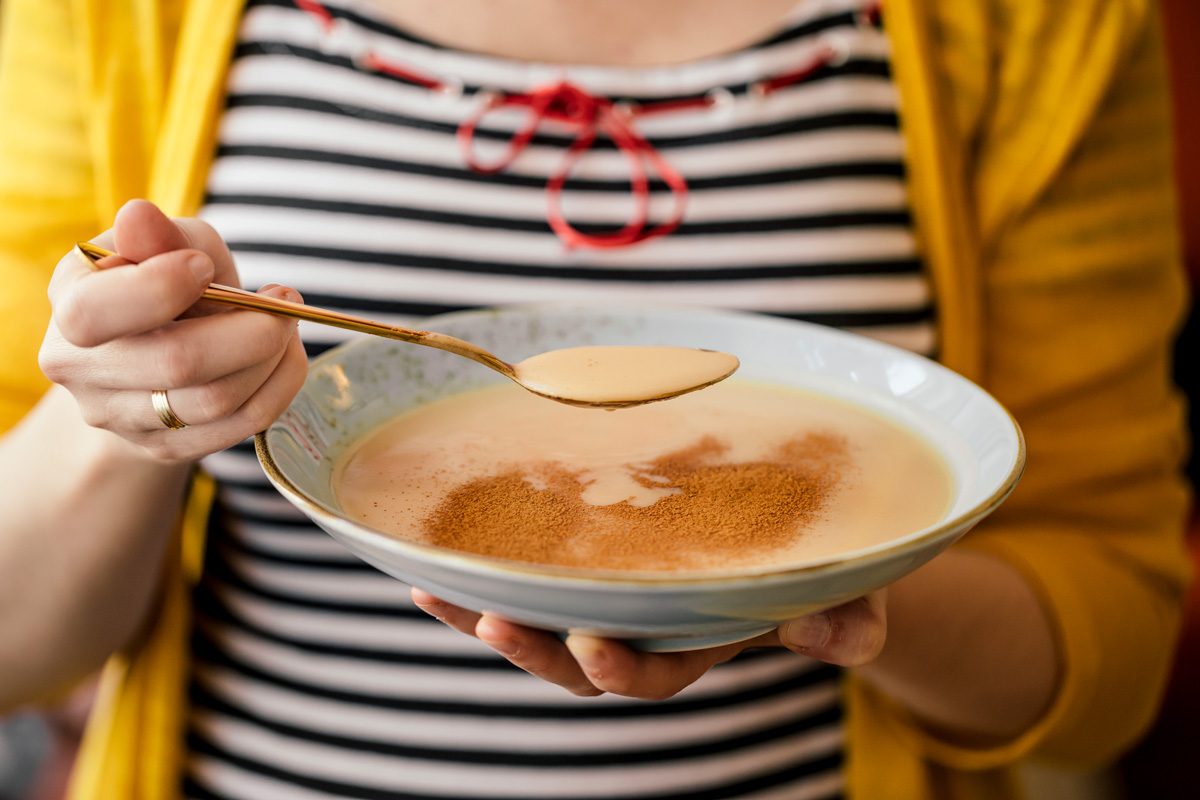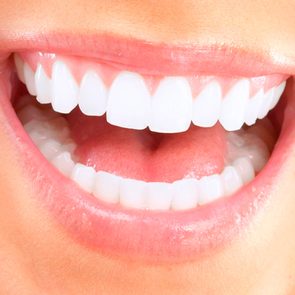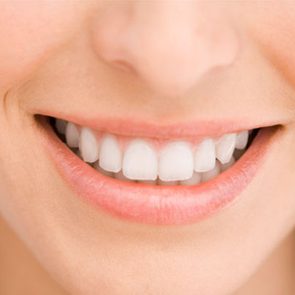Wisdom teeth removal requires eating soft or liquid foods to help with recovery. So, just what can you eat after wisdom teeth removal? Here's what to stock your pantry with before surgery.

What Can You Eat After Wisdom Teeth Removal?

While having your wisdom teeth out is typically seen as a teenage rite of passage, the truth is that people of all ages require orthodontic treatment to have these teeth removed.
Adults generally get their wisdom teeth, their third set of molars, when they are between 18-26 years old, says Christopher Norman, DDS, a dentist for the U.S. Army and the owner of Golden Smiles in Denver, Colorado. “The nickname wisdom teeth comes from the fact that they erupt into the mouth during the college years in the majority of adults,” Dr. Norman says.
It’s preferable to have them removed before the age of 20, explains Marc Sclafani, DDS, a dentist and the co-founder of One Dental in New York City. This typically makes the surgery and recovery easier. “Since teeth removed before age 20 have less developed roots and fewer complications, the American Dental Association recommends that people between 16 and 19 have their wisdom teeth evaluated to see if they need to be removed,” says Dr. Sclafani.
Whatever your age, however, wisdom tooth removal is sure to leave you feeling sore—and in search of something suitable to eat. So, what can you eat after wisdom teeth removal surgery?
Why you need to avoid certain foods after wisdom teeth removal surgery

Because wisdom teeth removal will leave you feeling tender for a couple of days—typically less than a week, says Les Latner, DDS, a dentist and owner of Westside Dental Associates in Los Angeles—you’ll want to look for soft foods that won’t irritate the wound.
After your wisdom tooth removal surgery, your mouth will feel extremely sensitive, tender, and sore. While this is only temporary, it’s important to take proper care in the meantime. Even though people are sometimes awake for wisdom tooth removal, it’s still surgery and you should take your recovery seriously.
“After the extraction, drink lots of liquids and eat soft, nutritious foods. Eating soft foods after dental surgery is necessary to ensure proper healing. We want to avoid food particles from interfering with the extraction site, and chewing hard foods can also cause pain and discomfort after surgery,” Dr. Sclafani says.
What can you eat after wisdom teeth removal surgery?
“After wisdom teeth extraction, you will probably be hungry—especially if you requested sedation because you would have been required to fast before the procedure,” says Fatima Khan, DMD, a dentist and co-owner of Riven Oral Care in Houston, TX.
That said, because a local anesthetic is used during wisdom teeth removal, dentists recommend waiting until the numbness wears off before consuming anything. “Everyone metabolizes the anesthetic at different rates, and some people may be numb a little longer than others,” Dr. Khan says. But generally, the numbness should wear off within about two hours.
After that, your dentist may recommend a liquid diet for the first 24 hours, Dr. Khan says. “However, you need to use a spoon, not a straw.” She explains that drinking through a straw can cause a clot in your mouth to dislodge, creating a dry socket that can cause excruciating pain.
By the second day of recovery, you can usually introduce soft foods—and Dr. Scalfani advises prioritizing nutrition to get you back on your feet faster: “A balanced diet of enough calories and plenty of protein can help the healing process. Protein helps build and repair muscle, skin, and tissue.”
We spoke with dentists for more ideal post-surgery food recommendations.

1. Soups and broths
Soup is an ideal food for post-surgery, says Dr. Latner. It’s nutritious and delicious, but doesn’t require potentially irritating chewing.
“Blended soups and broths are great,” agrees Dr. Sclafani. “They’re easy to eat, nutrient-rich and hydrating, and full of essential vitamins and minerals to aid recovery.”
Just take care to avoid soups with small seeds or large chunks, and stick to blended purees or broths. And, of course, make sure the soup isn’t too hot.
2. Yogurt
If your dentist recommends a liquid diet for the first day after wisdom teeth removal, you can still eat yogurt, Dr. Khan says. And you probably should—yogurt contains a range of nutrients, particularly protein, that can accelerate wound healing.
Yogurt is also a great source of probiotics. As you recover from wisdom teeth removal, a lack of movement and taking painkillers can cause stomach issues like constipation, and probiotics can help ease this discomfort. Plus, according to 2023 research published in the Journal of Personalized Medicine, probiotics may actually aid in pain relief.
3. Jell-O
Dr. Khan says that Jell-O is also safe to eat as a part of a liquid diet. Gelatin, the main ingredient in Jell-O, is known to help settle an upset stomach if you’re feeling a little queasy after surgery—which is why it’s often a staple item for hospital patients. As it’s mostly water, eating Jell-O is an easy way to stay hydrated as well.
Some research also suggests that gelatin may help aid in tissue repair and wound healing, such as a 2018 study published in The International Journal of Biochemistry & Cell Biology.
4. Nutritional shakes

Stocking up on ready-made nutritional shakes like Ensure or Boost is a convenient strategy for post-op recovery, according to Dr. Khan. This is because it can be tough to cover all your nutritional bases when on a restricted diet—and these drinks are formulated to provide easy calories and a wide range of essential vitamins and minerals.
You can also get up to 30 grams of protein in many meal replacement drinks, which is crucial for healing.
5. Scrambled eggs
After the first 24 hours, you can generally introduce “soft foods,” and scrambled eggs are one of the most popular recommendations after getting wisdom tooth surgery. “Scrambled eggs are great because they require very little chewing,” says Dr. Sclafani.
Not only are they super soft, quick to make (a bonus when you’re feeling tired post-surgery), and gentle on your mouth, but they’re also chock full of protein and nutrients, making them a particularly great choice.
6. Mashed fruits and vegetables
Following wisdom tooth removal surgery, Dr. Latner recommends anything soft, mushy, and mashed as a winner. Think mashed avocados, pureed sweet potatoes or carrots, apple sauce, or mashed bananas—all options that are rich in vitamins and minerals. “The softer, the better!” Dr. Latner says.
Just make sure your fruit or vegetable puree is completely smooth, Dr. Khan adds. For instance, if you’re making mashed potatoes, smooth out any chunks.
7. Smoothies

Instead of mashing your food, you can blend it up into a smoothie—and the benefit here is that you can easily add extra ingredients to ensure you’re getting enough nutrients. Dr. Sclafani is a fan of avocado smoothies post-surgery, and says that peanut butter can be added for extra protein. You can also blend in tofu, protein powder, chickpeas, or even cottage cheese for a nutritious protein boost.
Another tip? If you’re blending fruits that are a bit acidic (which can cause discomfort in your mouth post-surgery), include some Greek yogurt. This not only adds protein but also reduces the acidity level of the smoothie.
8. Oatmeal
Dr. Sclafani recommends oatmeal as an excellent food for post-wisdom tooth removal surgery. Not only is it soft, mushy, and perfect for sore jaws, but it’s nutrition-packed, too.
It’s important, however, to make sure that the oats are lukewarm and not hot when you eat them to avoid further irritating your mouth.
9. Cottage cheese
Dr. Khan points to cottage cheese as a great source of wound-healing protein. It’s also available in many different varieties, making it easy for anyone to add it to their diet after wisdom teeth removal. Depending on your dietary needs, you can get cottage cheese that’s lactose-free, low or nonfat, or sodium-free.
10. Ice cream and other cold foods

Ice cream as an official dietary recommendation by medical professionals? Yes, please.
Dentist Lilya Horowitz, DDS, FAGD, owner of Domino Dental in Williamsburg, Brooklyn, suggests ice cream or cold smoothies as part of the recovery process. “Stick with cold foods that are dissolved into liquid so that the food doesn’t get stuck in extraction sockets,” says Dr. Horowitz. Not only is ice cream a “safe” food, but, of course, it’ll be a nice treat as you recover from surgery.
Dr. Sclafani agrees that ice cream and other cold foods are a great bet. “Cold foods such as ice cream, Jell-O, smoothies, sorbet, milkshakes, and protein shakes may relieve some of the discomfort.”
However, it’s a good idea to avoid extreme temperatures—anything too hot or too cold—for the first three days after surgery, Dr. Khan adds. And remember: Don’t drink that milkshake through a straw.
11. Noodles
Comfort foods like mac and cheese or ramen are safe to eat when you’re on a soft foods diet, Dr. Khan says. In fact, well-cooked pasta and noodles are often recommended foods for the days following wisdom tooth removal. “Again, be careful with extreme temperatures and still avoid crunchy and hard foods,” she says.
Still, if you’re craving fast food like McDonald’s, your options are limited. Depending on how your healing is progressing, you may be able to grab a burger after about five days, but avoid french fries or fried chicken until the incision site is healed. However, fast food items like refried beans, mashed potatoes with gravy, baked beans, and milkshakes fit into the soft food diet plan.
What not to eat after wisdom teeth removal surgery

Regardless of what foods you gravitate toward, it’s key to avoid small pieces of food that might get caught in the wound socket and impede healing, says Dr. Latner.
Dr. Horowitz especially cautions patients to stay away from grainy and crunchy foods like cereal, nuts, and seeds until fully healed.
Greg Gelfand, DDS, a dentist and the clinical director of Gentle Dental in New York, also cautions patients away from small seeds, as well as hot and spicy foods and alcohol. “It can cause irritation and impede wound healing,” he explains. Generally, food that requires a lot of chewing should be avoided since post-surgical swelling can make chewing especially difficult.”
In a nutshell, the American Association of Oral and Maxillofacial Surgeons says to avoid these types of foods after wisdom teeth removal:
- Hard, crunchy foods
- Seeds, nuts, and popcorn
- Tough or difficult-to-chew foods, such as caramels, gummies, or jerky
- Acidic fruits, including oranges and tomatoes
- Spicy foods
- Hot drinks
When can I start eating solid foods?
“You should be able to return to a normal diet in about 10 days,” Dr. Khan says. Some people may be able to start eating solid foods sooner, while others need to wait a bit longer. It just depends on how fast you’re healing.
Before eating solid foods, you’ll want to make sure you’ve recovered enough from surgery. “You should not have any more bleeding, no swelling, the pain should have started to subside, and the site should start having gum tissue covering it,” Dr. Khan explains. However, she notes that it can take a couple of weeks for the tissue to completely cover the socket site.
Dr. Khan recommends introducing solid foods such as well-cooked vegetables and soft meat like salmon or tender chicken. “[Prioritize] proteins for wound healing and vegetables for vitamins and minerals,” she advises. “I would emphasize hydration as well.”
What to expect while you recover from getting your wisdom teeth removed

Luckily, it shouldn’t take too long for your teeth to begin to heal (meaning a modified diet is only temporary). Rhonda Kalasho, DDS, a Los Angeles-based dentist, says recovery for wisdom tooth removal surgery is under a week—usually one to five days.
Here’s what you can expect.
Swelling
Swelling will likely occur, with the most pain and swelling occurring on days two and three, says Dr. Kalasho. This is a common reaction to surgery and is nothing to be alarmed by.
Pain
Unfortunately, some pain is to be expected following wisdom tooth removal surgery.
“We always recommend staying ahead of the pain and taking the pain reliever prescribed to you by your doctor as soon as you get home, even if you do not feel pain yet,” says Dr. Kalasho, who says that throbbing and pressure are also normal.
Bleeding
Get queasy at the sight of blood? Try to prepare yourself mentally: Bleeding is common following wisdom tooth removal surgery.
If you’re experiencing daytime bleeding, roll up a piece of gauze and bite down on it, says Dr. Kalasho. This will help keep the bleeding at bay.
For nighttime bleeding, place a towel on top of your pillow and elevate your head.
About the Experts
|
For daily wellness updates, subscribe to The Healthy by Reader’s Digest newsletter and follow The Healthy on Facebook and Instagram. Keep reading:























